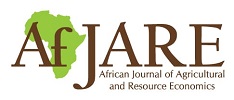Does crop diversification reduce downside risk of external maize yield-enhancing technology? Evidence from Ethiopia
Moti Jaleta, Paswel Marenya, Bedru Beshir, & Olaf Erenstein
Abstract
Unexpectedly lower yield outcomes (downside risks) challenge farmers’ use of external inputs that can enhance crop productivity. Using household-level panel data collected from Ethiopia, we estimated the effects of crop diversification through maize-legume intercropping/rotation on maize yield distribution and downside risk. Results from endogenous switching regression models and quintile moment approaches show that plots with maize-legume intercropping/rotation have the highest average maize yield. Such crop diversification reduces the downside risk in maize yield more when applied to plots receiving external inputs. The results imply that, in addition to the technical support around external input use in smallholder maize production, Ethiopia’s agricultural extension may also need to give due emphasis to both spatial and temporal crop diversification practices. This could enhance crop productivity further and reduce the potential downside risks typically hampering smallholders’ external input use in maize production.
